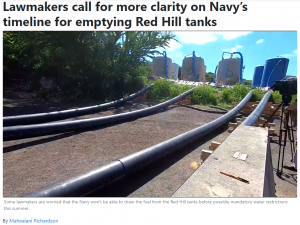Red Hill Update: Questions Remain
Piping remediation remains an unknown
Recent contamination of water systems by jet fuel leaking from the Navy’s Red Hill fuel storage facility in Hawaii illustrates again the importance of safe drinking water and of the piping that delivers it. As the situation evolves, Safe Piping Matters is sharing developments along with recommendations based on research studies and lessons learned from previous contamination events.
Many questions remain about this incident, including one that has been largely ignored to date:
How will the Navy and local officials repair or replace pipes impacted by chemicals released into the system?
Research highlights a number of piping hazards that put human health and safety at risk:
- Most important are the issues posed by polluted soil and groundwater, which represent a continuing problem. In an interview with Hawaii News Now, State Representative Bob McDermott asked, how do you remediate… the side of a mountain that’s full of gas?” He estimated it will take “best case 3 years, probably closer to 10, if at all,” and “$4 billion…on the low side.” This has huge implications for piping because until they are fully removed, toxic chemicals in the environment will threaten pipes.
- For example, research into other chemical spills shows flushing water pipes does not fully remove contamination. Chemicals adsorb onto the inside of pipe walls, meaning they can re-enter the water supply, especially during periods of lower use. PVC pipes are especially at risk because this plastic material adsorbs about “180% more” in comparison to metal.
- Likewise, chemicals that remains in polluted soil and groundwater can permeate through pipe walls to re-contaminate the water. Sections of piping constructed from plastic materials are especially prone to permeation by chemical pollutants.
Other important questions that need answers:
- How much contamination remains in the area? In an interview with Honolulu news station KHON, Ernie Lau, Chief Engineer of the local Board of Water Supply, cited the Navy’s own risk assessment as giving a 27% chance each year that spills will occur. The rate may be much higher: the Sierra Club found a state filing showing 73 releases of fuel at the Red Hill facility just since 2014.
- Is the contamination spreading? Lau noted that samples are showing contamination in multiple new areas, which prompted him to ask if the Navy was “trying to hide something.”
- How will exposures impact families who consumed toxic chemicals in the water? Longer-term effects from the poisoning include seizures and urinating blood. Residents are demanding health monitoring and treatment for conditions caused by the contaminated water. Safe Piping Matters has previously outlined recommendations to help protect them moving forward.
Finding solutions really matters – not just to the thousands of people directly affected, but also to the entire population of Oahu. Fears of continuing contamination have shut down wells that supply Honolulu and surrounding communities. In fact, it’s possible the incident could put a stop to all development on the island. Wayne Tanaka, president of the Sierra Club’s Hawaii chapter, calls the fallout from Red Hill “a crisis of existential proportions right now.” Some residents have already given up and left Hawaii – said one: “I don’t trust the water. I don’t trust the government. I don’t trust the navy… You can’t live without water.”
From Hawaii News Now Report, 03/2022
Water Hell in Hawaii
The crisis on Oahu emerged in late 2021, when at least 19,000 gallons of jet fuel from the Navy’s Red Hill storage facility leaked into area wells, continuing a long string of problems there.
The leak affected the homes of about 90,000 area residents, many of whom suffered rashes, headaches, stomach cramps, vomiting and other health problems. Toxic chemicals in tap water flowing from pipes measured 350 times higher than safe limits.
The Navy failed to act or notify officials of the spill until community activists – and the unfolding health crisis – forced their hands. In fact their first response was to illegally dump contaminated water onto streets and sidewalks. The Navy later began flushing and filtering the water, declaring it “safe” in mid-March 2022.
Hawaii radio station KHPR has a more detailed breakdown
